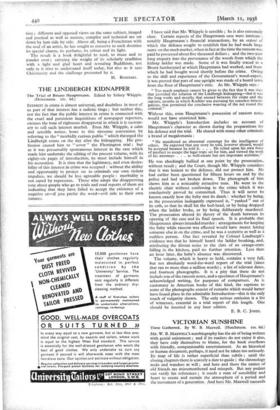THE LINDBERGH KIDNAPPER
The Trial of Bruno Hauptmann. Edited by Sidney Whipple. (Heinemann. iOs. 6d.)
INTEREST in crime is almost universal, and doubtless in most of us part of that interest has a sadistic tinge ; but neither this, nor the fact that the public interest in crime is connected with the cruel and persistent inquisitions of newspaper reporters, excuses the tone of righteous disapproval in which it is custom- ary to call such interest morbid. Even Mr. Whipple, a calm and sensible writer, bows to this tiresome convention by referring to the " morbidly curious public " which thronged the Lindbergh estate on the day after the kidnapping. His pro- fession caused him to " cover " the Flemington trial ; but as it was presumably spontaneous interest in the case which made him undertake the editing of the present volume, with its eighty-six pages of introduction, he must include himself in his accusation. It is time that the legitimacy, and even desira- bility of this interest in crime was accepted : without the ability and opportunity to project on to criminals our own violent impulses, we should be less agreeable people : morbidity is not cured by repression. Those who adopt the disapproving tone about people who go to trials and read reports of them are indicating that they have failed to accept the existence of a negative or—if you prefer the word—evil side to their own natures.
I have said that Mr. Whipple is sensible ; he is also extremely
clear. Certain aspects of the Hauptmann case were intricate : notably Hauptmann's financial transactions, by an exposé of which the defence sought to establish that he had made large sums on the stock market, when in fact at the time the ransom was paid he possessed about five thousand dollars ; and the two-year long enquiry into the provenance of the woods from which the kidnap ladder was made. Some of it was finally traced to a
Bronx lumberyard at which Hauptmann had worked, and from which he had bought wood shortly before the crime. Owing to the skill and experience of the Government's wood-expert, it was proved that part of one upright was made of a board sawn from the floor of Hauptmann's attic. As Mr. Whipple says :
" Too much emphasis cannot be given to the fact that It was time that provided the solution of the Lindbergh kidnapping—that it was the long weeks and months that ensued between the crime and the capture, months in which Koehler was pursuing his ceaseless investi- gations, that permitted the conclusive weaving of the net round the criminal."
Without this, even Hauptmann's possession of ransom notes would not have convicted him.
Mr. Whipple's Introduction includes an account of Hauptmann's character as shown during the preparations for his defence and the trial. He shared with many other criminals a brand of megalomania :
" He manifested an abnormal contempt for the intelligence of others. He expected that any story he told, however absurd, would be accepted because he told it. . . . He relied upon his own force of intellect to escape the legal traps set for him, and viewed the work of his attorneys . . . as well-meant but not important activities."
He was shockingly bullied at one point by the prosecution, without result ; and the Court, though Mr. Whipple considers that it was lenient to the defence, did not protect him. He had earlier been questioned for fifteen hours on end by the police and had not broken down. The photograph of him shows him as a noticeably attractive man. He went to the electric chair without confessing to the crime which it was conclusively proved he committed. Thus it will never be known exactly how the baby met its death : whether by being, as the prosecution inelegantly expressed it, " yanked " out of its crib, so that its skull hit the bed-head, or by being dropped when the ladder broke, or by being deliberately murdered. The prosecution altered its theory of the death between its opening of the case and its final speech. It is probable that Hauptmann always intended murder : arrangements for keeping the baby while ransom was effected would have meant letting someone else in on the crime, and he was a secretive as well as a ruthless person. One fact revealed by Colonel Lindbergh's evidence was that he himself heard the ladder breaking, and, attributing the distant noise to the slats of an orange-crate falling in the kitchen, paid no further attention. Less than an hour later, the baby's absence was discovered.
The volume, which is heavy to hold, contains a very full, but not absolutely word-for-word report of the trial (since that ran to more than a million words) ; a list of relevant dates, and fourteen photographs. It is a pity that these do not include one of the ransom notes, and a specimen of Hauptmann's acknowledged writing, for purposes of comparison. As is customary in American books of this kind, the captions to some of the photographs consist of remarks which would better have found place in the admirable Introduction—this is the only touch of vulgarity shown. The only serious omission is a list of witnesses, essential in a trial report of this length. One should be inserted in any later edition.
E. B. C. JoxEs.










































 Previous page
Previous page